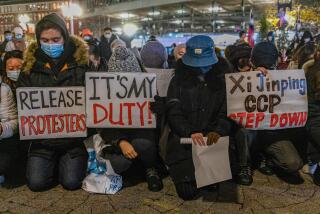Beijing May Reassess Tian An Men : China: Leadership sends signals that it may soften hard-line stand on 1989 pro-democracy movement.
- Share via
BEIJING — Almost six years after tanks roared into this capital to suppress pro-democracy demonstrations in Tian An Men Square, the Communist Party leadership has sent signals that it is preparing to reverse the official verdict of the 1989 protest movement as “counterrevolutionary.”
Any official reassessment of the Tian An Men incident, in which hundreds and perhaps thousands died when army units opened fire on unarmed civilians, will have important consequences in the succession struggle expected to follow the death of senior leader Deng Xiaoping.
Deng, 90 and in failing health, is believed to have issued the final command ordering the army into central Beijing.
Since then, Deng and his family--most recently daughter Deng Rong on a tour of France and the United States--have strongly defended the military crackdown.
But in recent weeks, Deng’s handpicked successor, Communist Party General Secretary Jiang Zemin, has moved on several fronts to distance himself from the Tian An Men episode.
The latest sign of a softening in the hard-line official stand came Thursday when Yuan Mu, who acted as government spokesman defending the bloody June 4, 1989, crackdown, was dismissed from his job as head of the State Council research office.
The dismissal followed the forced resignation last month of Beijing Communist Party chief Chen Xitong, who as Beijing mayor in 1989 wrote the official report condemning the Tian An Men Square demonstrators as “counterrevolutionaries.” The report led to the arrest and detention of as many as 30,000 who participated in the democracy movement.
Jiang’s conciliatory tone first surfaced in March when he quietly visited the tomb of reformist leader Hu Yaobang in Jiangxi province.
It was Hu’s death on April 15, 1989, that sparked the first demonstrations in Tian An Men Square, the Chinese capital’s sprawling central place that has often figured in key historical events.
*
Unreported in the Chinese press, the Jiang trip to the tomb site in Gongqingcheng in March was confirmed to The Times on Friday by Wu Fuan, a spokesman for the Jiangxi provincial government.
“Perhaps I am giving Jiang too much credit,” UCLA political scientist Richard Baum said, “but it looks like he [Jiang] is trying to let go of Deng’s shirttails before they drag him to an early political demise.”
Although a visit to a tomb in rural China might seem insignificant in a Western, democratic context, such gestures carry great weight here, where cryptic utterances of aging leaders are weighed and analyzed for years. Momentous changes are often heralded by a mere change in phrasing.
In the past several years, for example, there have been pressures from the reformist wing of the Communist Party to downgrade the Tian An Men demonstrations from “counterrevolutionary acts” to “public disturbances.”
Jiang, who was Communist Party chief in Shanghai at the time, was politically untainted by the 1989 crackdown.
But others in the senior ranks of Chinese leaders, including Premier Li Peng, a chief defender of the military action, would be vulnerable in any revision that changed the official take on the incident.
Another example of the shifting, more conciliatory mood by the party leadership toward the 1989 movement came on Monday when 44 prominent intellectuals were permitted to circulate a petition calling for a “reappraisal of the June 4th incident.”
“We decided to send this petition to the government now because we think the situation in our country has become sufficiently serious to try to change things,” the petition’s author, science historian Xu Liangying, 75, told Agence France-Presse.
The petitioners justified the timing of their petition, citing the United Nations’ declaration of 1995, the world organization’s 50th anniversary, as the “Year of Tolerance.”
“I can only hope the spirit of tolerance will dominate,” Wu Zuguang, a petition-signer and playwright, said in a telephone interview.
The petitioners--who included the nuclear physicist who designed China’s first atomic bomb, as well as many other noted scientists and writers--also called for the “release of all people concerned [with the June 4, 1989, incident] who are in jail.”
A key test of the government’s resolve in repairing the damage of the Tian An Men crackdown will come on June 19, the date the last prominent student leader of the democracy movement is scheduled to be released from prison.
Liu Gang, 33, is a former physics student sentenced to six years in prison on charges of “conspiracy to subvert the government.”
While all other leaders in the movement have been released, often under pressure from the U.S. government, the unrepentant Liu has remained in a Liaoning province prison serving out his term.
Periods of political transition in China have been marked by a review of recent history, revision of the main political line and rehabilitation of those who suffered under previous regimes.
When Deng came to power in 1979, he ordered the rehabilitation of those prosecuted as “counterrevolutionaries” for participating in an April, 1976, protest, also in Tian An Men Square.
According to one prevalent political theory, the next leader of China will have to preside over a similar re-evaluation of the 1989 military crackdown in Tian An Men Square and surrounding avenues.
But not everyone believes that Jiang or other Chinese leaders trying to revise the verdict on Tian An Men will win public support.
“In order to re-evaluate a historical event like this,” a young businessman said, “you have to blame the event on someone. . . . Regarding the June 4th incident, there is no clear scapegoat.”
More to Read
Sign up for Essential California
The most important California stories and recommendations in your inbox every morning.
You may occasionally receive promotional content from the Los Angeles Times.













